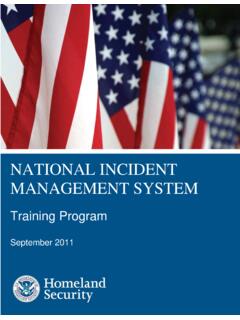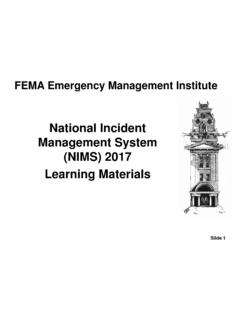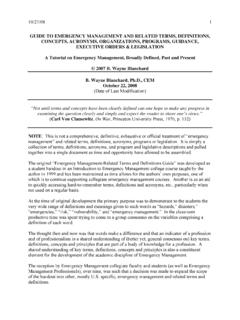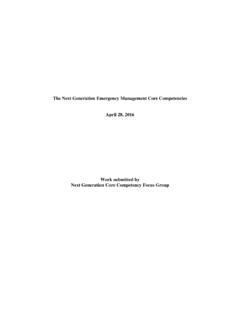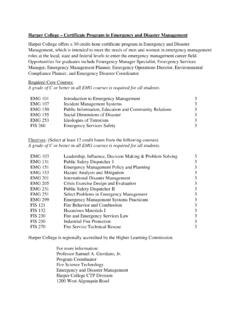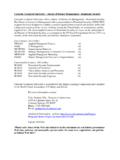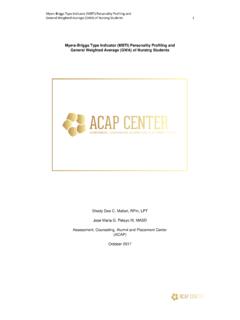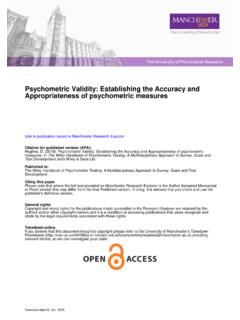Transcription of Decision Making and Problem Solving
1 Decision Making and Problem Solving Independent Study November 2005 FEMA TABLE OF CONTENTS Decision Making and Problem Solving Page i Page Course 1 Unit 1: Course Introduction Introduction .. Decisions in Emergency Management .. Case Study Sebring County .. Decision Points .. What s at Stake?.. About This Course .. Activities and Exercises .. Job Aids .. Knowledge Checks .. Appendix .. Course How Will You Benefit? .. How to Complete This Course .. Sample Learning Goal Setting .. Activity: Personal Learning Goals .. Summary and Transition .. Unit 2: The Decision - Making Process Introduction .. Problem Solving vs. Decision Making .. Where Does the Process Begin?.. Case Study Mandatory or Voluntary Evacuation?
2 The Starting Point .. Recent Changes to Emergency Planning Problem - Solving Model .. Step 1: Identify the Step 2: Explore Case Study What Are Your Options? .. Step 3: Select an Step 4: Implement the Solution .. Activity: Implementing the Solution .. Step 5: Evaluate the Activity: Evaluating Your Solution .. Summary and Transition .. For More Information .. Knowledge Check .. COURSE OVERVIEW Decision Making and Problem Solving Page ii Page Unit 3: Identifying Decision - Making Styles and Attributes Introduction .. What Is Psychological Type?.. What Are Preferences?.. Using Type Inventories to Determine Preferences .. The Myers-Briggs Type Indicator .. Preferences and Decision Making .. Activity: Where Should You Flex?
3 Who Decides?.. Successful Group Decision Making .. Activity: Individual or Group Decision ? .. What Is an Effective Decision Maker? .. Attributes of an Effective Decision Maker .. Activity: Identifying Your Strengths and Limitations .. Summary and Transition .. For More Information .. Knowledge Check .. Unit 4: Ethical Decision Making and Problem Solving Introduction .. What Is Ethics? .. Ethical Issues and Activity: Ethical Issues and Emergencies .. Components of Ethical Decision Making .. Applying the Problem - Solving Model to Ethical Issues .. Activity: Applying the Problem - Solving Model to Ethical Issues .. Summary and Transition .. For More Information .. Knowledge Check .. Unit 5: Decision Making in an Emergency Introduction.
4 Decision Making and Stress .. Case Study: Hurricane Hortence .. Summary and Transition .. Unit 6: Course Summary Introduction .. The Decision - Making Process .. The Problem - Solving Decision - Making Attributes of an Effective Decision Maker .. Ethical Decision The Final Appendix A: Job Aids Course Overview COURSE OVERVIEW Decision Making and Problem Solving Page 1 About This Course Being able to make decisions and solve problems effectively is a necessary and vital part of the job for every emergency manager, planner, and responder. This course is designed to improve your Decision - Making skills. It addresses: The Decision - Making process Decision - Making styles Attributes of an effective Decision maker Ethical Decision Making and Problem Solving FEMA s Independent Study Program FEMA s Independent Study Program is one of the delivery channels that the Emergency Management Institute (EMI) uses to provide training to the general public and specific audiences.
5 This course is part of the Federal Emergency Management Agency s (FEMA s) Independent Study Program. In addition to this course, the Independent Study Program includes courses in radiological emergency management,the role of the emergency manager, hazardous materials, and disasterassistance. FEMA s independent study courses are available at no charge and include a final examination. You may test individually or through group training. COURSE OVERVIEW Decision Making and Problem Solving Page 2 FEMA s Independent Study Program FEMA Independent Study Program Administrative Office Emergency Management Institute 16825 South Seton Avenue Emmitsburg, MD 21727 (301) 447-1200 Information about FEMA s Independent Study Program also is available on the Internet at: and click on FEMA Independent Study Final Examination This course includes a Final Examination, which you must complete and submit to FEMA s Independent Study Office for scoring.
6 To obtain credit for taking this course, you must successfully complete (75 percent correct) this examination regardless of whether you complete this course through self-instruction or through group instruction. You may take the Final Examination as many times as necessary. Course Completion Decision Making and Problem Solving has no prerequisites. COURSE OVERVIEW Decision Making and Problem Solving Page 3 How to Complete This Course Work through this course at a pace that is comfortable for you. You should resist the temptation to rush through the material, however. Take enough time with each unit to ensure that you have mastered its content before proceeding to the next. Knowledge Checks To help you know when to proceed, each unit is followed by a Knowledge Check that addresses the material contained in the unit.
7 The Knowledge Check asks you to answer questions that apply to what you have learned in the unit. The answers to the Knowledge Check follow each Knowledge Check. When you finish each exercise, check your answers, and review the parts of the text that you do not understand. Do not proceed to the next unit until you are sure that you have mastered the current unit. When you have completed all units, take the Final Examination online, or use the answer sheet (if provided in your course packet). EMI will score your test and notify you of the results. Begin the Course You may begin the course now. Unit 1: Course Introduction UNIT 1: COURSE INTRODUCTION Decision Making and Problem Solving Page Introduction Decision Making and Problem Solving are critically important skill areas for emergency managers, planners, first responders, voluntary agency coordinators, and other professionals in emergency management.
8 As an emergency management professional, your ability to identify current and potential problems and to make sound, timely decisions before and during an emergency can literally affect the lives and well-being of the local citizenry. Your decisions can impact the ability of response agencies to do their jobs and can make the difference in how quickly the community is able to recover from an event. Decisions in Emergency Management How often are your Decision - Making abilities tested when an emergency threatens? Let s begin with an example. Review the case study that is provided on the next page. UNIT 1: COURSE INTRODUCTION Decision Making and Problem Solving Page Case Study Case Study Sebring County Instructions: Read the following case study. As you read, try to identify what decisions must be made by the emergency manager or other emergency management officials.
9 Jot down your ideas before continuing. Background: Heavy rainstorms have hit, and counties across the entire State are faced with flash flooding to varying degrees. The town of Westfield located in Sebring County, one of the hardest hit counties in the State sits high and well away from the river, so flooding is usually not a concern. Last year, a new spillway was built to increase the capacity of the town reservoir to about 44 million gallons. Two towns downstream, Ambry and Gilson, are less than a 5-minute drive from Westfield. Each town has about 2400 residents, most of them along Route 270. Event chronology: Late afternoon Rain begins, and weather forecasters predict it will be a strong, slow-moving storm, which will produce heavy rain. 7:41 A flash flood watch is issued by the National Weather Service.
10 8:00 Heavy rains begin. 9:30 The county engineer stations an employee on the dam to watch for and report any problems. The employee sees water pouring a good 2 feet over the spillway. (It was later estimated that the reservoir was holding 65 million gallons during and after the storm.) 11:00 Five inches of rain have fallen over the last 3 hours. 12:30 The employee sees a section of dirt break away. 1:00 When water recedes below the top of the dam, county employees discover that water has eaten around the spillway and is gradually carving away the side of the earthen dam. A first attempt at closing the hole with sandbags fails when the force of the water carries the bags right through. 1:30 The Sebring County Emergency Program Manager is now meeting with the mayor of Westfield, the county engineer, the public works director, the fire chief, and the police chief to discuss the situation.

